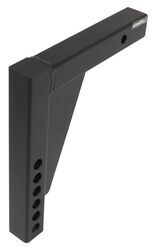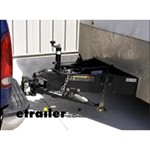
Replacement Weight Distribution Shank and Spring Bars
Question:
Hello, I have a 21 ft bumper pull travel trailer 2005-2006 Keystone hornet 21 RSLS and currently purchased a new Ford F250 super duty diesel to pull it. I had a 2007 GMC Sierra 1500 that we used to pull this trailer and it suffered the whole trip 4300 -5200 rpm. This pickup stands taller so my old round bar load leveling hitch will no longer work. I am looking to purchase the 1400 lb equalizer load leveling anti sway control hitch as we may upgrade our camper to something larger. Currently my pickup stands from the driveway measured up to the inside top of the 2.5 inch receiver 20.75 inches and my trailer riding level measures from the ground to the bottom of the tongue 13.625 inches and from the ground to the top of the tongue 16 inches if i do the math that i saw on a youtube video i would need a 7 inch which but after watching a video on your website this may not be true. What size 2. 5 in shank would I need as well as the part number for an appropriate equalizer hitch for this combination to pull level. Thank you
asked by: Barry B
Expert Reply:
We can help you with a different weight distribution shank to give you the amount of drop you need to keep your hitched trailer level with the new truck. All 2-1/2-inch shanks are shown on the linked page. For example, Reese shank # RP54977 offers 5-3/4-inches of drop.
If none of the 2-1/2-inch shanks have the drop you need you can use a reducer sleeve # BX88187 in your hitch to allow use of a 2-inch shank. We offer many more shanks in this hitch size and you can see them on the other link. An example, is Curt 2-inch shank # C17124 which provides up to 10-inches of drop with round bar systems and up to 9-inches of drop with trunnion bars.
In terms of the weight distribution system's capacity you really want your fully loaded trailer's actual tongue weight (TW) to fall in the middle of the system's operating range. All WD/SC systems have a compatible TW range and your total TW (which consists of the measured trailer TW plus the weight of any cargo in the truck that is behind the rear axle) should fall near the middle of that range. If your system is rated too high for the trailer you can have stiff handling and if it is too low it will not be able to shift the trailer TW forward to the front axle.
It is often possible to simply swap just the spring bars in a WD system to different ones rated for the TW of your new trailer. You may not need a whole new system at all. This can let you adapt to a new trailer's TW without the expense of a whole new system.

Products Referenced in This Question
Blue Ox Hitch Reducer Sleeve - 2-1/2" to 2" Trailer Hitch
- Hitch Adapters
- Hitch Reducer
- Bike Racks
- Cargo Carriers
- Hitch Mounted Accessories
- No Extension
- Fits 2-1/2 Inch Hitch
- 2-1/2 Inch to 2 Inch
- Blue Ox
more information >
Curt Weight Distribution Shank 13" Long - 9" or 10" Drop - 1,500 lbs TW
- Accessories and Parts
- Weight Distribution Hitch
- Shanks
- 1600 lbs TW
- 16000 lbs GTW
- Fits 2 Inch Hitch
- Round - 9 Inch Drop
- Trunnion - 7 Inch Drop
- CURT
more information >







